Abstract
Focused on the contradiction between the steady-state error of active power and the dynamic oscillation caused by the virtual damping characteristics of the virtual synchronous generator (VSG) under disturbances during grid-connected operation, this article proposes an adaptive virtual inertia regulation and compensation method (PFFCVSG_AJ) based on an active power differential feedforward compensation strategy (PFFCVSG). Firstly, this article presents the working and control principles of VSG, analyzing its control mechanisms through a small-signal model. Models for VSG’s active power, reactive power, and virtual impedance components are established, with particular focus on the impact of the damping coefficient on active power regulation. Based on the PFFCVSG, an adaptive virtual inertia adjustment method is introduced to resolve the inherent inertia deficiency in PFFCVSG control, the influence of the moment of inertia on PFFCVSG is theoretically analyzed, and a dynamic adjustment mechanism for moment of inertia is developed based on the rate of change in frequency (RoCoF). Finally, simulation validation using MATLAB/Simulink (MathWorks, R2022b, Natick, MA, USA) demonstrates that the proposed PFFCVSG_AJ strategy effectively eliminates active power steady-state deviation, suppresses active power dynamic oscillation, and mitigates the frequency overshoot issue prevalent in traditional PFFCVSG. Experimental verification is conducted via a TMS320F28378DPTPS-based control platform, confirming the algorithm’s effectiveness under sudden load variations, and that the power quality of the power grid is not affected under the premise of efficient grid connection.
1. Introduction
The “dual-carbon” initiative has spurred the widespread integration of green renewable energy sources like photovoltaic and wind power into the power grid. These energies generally use power electronic converters as the interface for friendly interaction with the grid, which makes the traditional power system with synchronous generators (SGs) as its main body exhibit the characteristics of a weak grid with weak voltage support and low inertia [1,2]. Energy storage converters, with their fast and flexible energy management capabilities, have emerged as a key solution to ensure the stable operation of power electronic systems. The VSG simulates the stator electrical equation and rotor motion equation of SGs and has the ability to simulate voltage support and inertia similar to SGs, garnering significant attention from global researchers [3,4].
Nevertheless, the inertia emulation capability turns the active power loop into a canonical second-order system, potentially causing low-frequency power oscillations. To solve this problem, a damping term is usually added to the oscillation equation to suppress the low-frequency power oscillation phenomenon; however, research has shown that adding this damping term effectively elevates the VSG droop coefficient. According to grid specifications, when the droop coefficient remains unchanged, the damping ratio usually proves insufficient [5,6], which also indicates that with the introduction of the damping ratio, the droop coefficient will increase, thus changing the active power steady-state operating point (SSOP). Therefore, there is a critical need to enhance virtual damping by introducing additional transient damping without impacting the droop coefficient. Achieving this goal typically involves two approaches: adding an additional damping control loop in the control loop and damping adaptive control [7].
The method of adding an additional damping control loop mainly improves the dynamic performance without changing the steady-state performance by adding an additional damping auxiliary branch. In [8], the authors propose a method of forming an additional damping through the feedback of output active power and reactive power; however, this method involves reactive power division operations, and in application, the denominator may be zero, causing the system to crash. The authors propose a frequency differential feedback compensation strategy [9]; however, in practical applications, it is relatively difficult to collect the output frequency of VSG, so using it as a control feedback loop is likely to cause large errors. The authors in [10] propose an optimization strategy for the grid-connected active power response of energy storage VSG based on frequency feedforward compensation. This strategy can effectively eliminate the grid-connected active power dynamic oscillation and active power steady-state error under the step change in the active power command. However, it does not analyze the active power response problem under grid frequency disturbance. [11] proposes a damping enhancement strategy based on the complex torque model, which introduces an auxiliary branch into the power control loop. This strategy does not affect the original droop characteristics and steady-state operating point, and is effective under wide short-circuit ratio conditions. However, incorporating the auxiliary branch increases the hardware cost of system control. In [12], the authors present a method based on the idea of differential lead correction, which feeds active power back onto the frequency deviation to increase system damping and suppress oscillations. Nevertheless, the article does not fully discuss the impact of this strategy on other performance indicators such as voltage stability. The authors in [13] propose an SSO suppression strategy based on the VSG dynamic inertia damping coefficient. Based on the active damping method of modulation signal feedback, the VSG moment of inertia and virtual damping coefficient are dynamically adjusted to achieve subsynchronous oscillation suppression and suppress the offset of the VSG operating point. However, the change in short circuit ratio (SCR) in this method will seriously affect the interaction between inductance and impedance, thus affecting the adaptability of the strategy. In [14,15], the authors propose the PFFCVSG, where the active power oscillation of the VSG is reduced by first-order inertia and differential link, but during the frequency control, a frequency overshoot phenomenon will occur, posing a certain risk.
Compared to the method of adding an additional damping control loop, damping adaptive control usually realizes performance adjustment by dynamically adjusting control parameters [16,17,18]. The authors in [19] propose a mathematical constraint method based on collaborative control, which can calculate the inertia coefficient and damping coefficient to ensure that the system operates at the optimal damping ratio. The authors in [20] propose a mathematical constraint method based on collaborative control, which can calculate the inertia coefficient and damping coefficient to ensure that the system operates at the optimal damping ratio. However, implementing damping adaptive control imposes relatively high demands on the controller, while systemic delays and noise interference in practical applications compromise the accuracy of adaptive adjustments, leading to significant coefficient tracking errors [21].
To address the above challenges, this paper proposes a method based on tracking the rate of change in frequency (RoCoF) based on PFFCVSG. Aiming at the insufficient inertia support ability of the active power differential feedforward compensation strategy, an adaptive virtual inertia method is introduced. By analyzing the influence of the virtual inertia on PFFCVSG, the expression of the added adaptive virtual inertia is introduced. MATLAB/Simulink (MathWorks, R2022b, Natick, MA, USA) simulation verify that the proposed method effectively reduces frequency overshoot during tracking, resolving this phenomenon. Through this adding of additional damping, the transient damping of the VSG system is enhanced, effectively suppressing low-frequency oscillations and addressing steady-state error issues. The main contributions of this study are summarized as follows:
- This study presents the stator and rotor equations of the VSG, elaborating on control sections including active frequency modulation, reactive voltage regulation, and virtual impedance control. The voltage and current double closed-loop control structure based on is adopted, and the small-signal model is derived. This part is located in Section 2 of the article.
- The impact of the damping coefficient on active frequency modulation is analyzed, revealing that increasing the coefficient reduces low-frequency oscillations but induces active steady-state errors. This part is located in Section 3 of the article.
- PFFCVSG is systematically investigated using a small-signal model. The effects of the compensation coefficient and lag time constant are analyzed, parameter setting methods are provided, and the frequency overshoot issue is highlighted. This part is located in Section 4 of the article.
- Identifying weakened inertia as the cause of frequency overshoot in PFFCVSG, an active feedforward compensation strategy based on adaptive virtual inertia (PFFCVSG_AJ) is proposed. The article presents the variation range of the adaptive virtual inertia constant, details its control method, and presents the theoretical basis for the method to adjust in the face of power grid frequency changes and sudden load mutations. This part is located in Section 5 of the article.
Comparative simulations under grid frequency disturbances, active power variations, and different initial virtual inertia settings validate the improvements of the proposed method. Additionally, by constructing an experimental platform and conducting tests under external disturbances such as sudden load increases and decreases, the research confirmed its effectiveness in addressing active power oscillations, steady-state errors, and frequency overshoot issues. The simulation results and experimental results are presented in Section 6 and Section 7 of this article, respectively.
2. Analysis of the Control Principle and Small-Signal Model of the VSG
2.1. Basic Control Principle of VSG
2.1.1. Synchronous Machine and Virtual Synchronous Generator
Figure 1 depicts a schematic representation of a three-phase synchronous machine [22]. Here, and denote the rotor’s excitation current and voltage, respectively, while represents the maximum mutual inductance between the excitation winding and the three-phase stator coils. The rotor angle relative to the a-phase stator winding is denoted as , the stator’s three-phase currents are signified as , , and . The stator winding parameters include resistance and inductance , while represents the back electromotive force induced by the rotor in the stator. Through the construction of an equivalent circuit and the application of Kirchhoff’s laws, the electromagnetic equations of the synchronous generator can be derived.
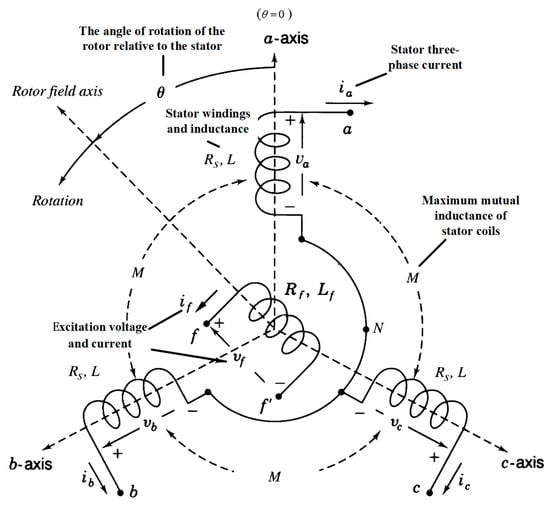
Figure 1.
Schematic diagram of a synchronous generator.
Since the synchronous machine is also a type of motor, it satisfies the swing equation of the motor. Thus, the rotor swing equation of the synchronous generator is obtained as follows:
In Equation (2), and denote the second-order and first-order derivatives of . represents the mechanical torque of the motor, stands for the electromagnetic torque, is the moment of inertia, and is the damping coefficient. and denote the mechanical power and electromagnetic power of the synchronous generator.
Based on the stator and rotor equations, microgrids equipped with virtual synchronous generators (VSGs) can participate in frequency and voltage regulation by emulating output characteristics such as inertia and damping. This approach helps enhance the stability, dynamic performance, and power quality of microgrids, enabling better adaptation to the challenges posed by the integration of renewable energy sources into the grid.
2.1.2. Active Power–Frequency Control and Reactive Power–Voltage Control
The prime mover supplies mechanical energy and torque to the synchronous generator. A speed governor is incorporated to stabilize grid frequency and balance active power among parallel generating units. Simultaneously, the excitation system regulates reactive power distribution to maintain stator voltage stability.
The droop characteristic between active power and frequency of the speed governor is as follows:
In the equation, is the reference active power; is the active power–frequency droop coefficient; is the reference frequency, usually the grid frequency; and is the VSG output frequency.
Substituting it into the rotor swing equation of the motor:
Finally, the frequency regulation characteristic equation of VSG is obtained through Laplace transformation:
The active power–frequency control structure can be obtained from the characteristic equation, as shown in Figure 2.

Figure 2.
Active power–frequency control structure.
Using the droop characteristic for analysis:
In the equation, is the effective value of the VSG output voltage, and is the reactive power–voltage droop coefficient.
By changing the equation, the reference value of the reactive power output can be obtained:
After passing through the PI controller with the electromagnetic , the reference electromotive force is obtained:
Thus, the output virtual electromotive force of the VSG reactive power voltage regulation link is obtained:
The reactive power voltage regulation control structure is established by modeling the virtual electromotive force, as shown in Figure 3.

Figure 3.
Reactive power–voltage control structure.
2.1.3. Virtual Impedance Control Structure
The output of active frequency regulation and reactive voltage regulation corresponds to the three-phase grid inverter’s output. As the parameters fed into the subsequent voltage–current double closed-loop control structure are the voltage and current signals after LC filtering, this necessitates a VSG module to emulate the stator resistance and synchronous reactance of a synchronous generator [23]. The inverter output is converted into the point of common coupling (PCC) voltage and current for the subsequent double closed-loop control through an LC filter.
Through modeling the inverter and applying coordinate transformation, the following can be obtained:
By transformation, the mathematical expression of the virtual impedance control link is obtained as Equation (12), and the virtual impedance control structure is shown in Figure 4.

Figure 4.
Virtual impedance control structure.
2.1.4. The -Based Dual-Loop Control for Voltage and Current
The block diagram of the -based dual-loop control for voltage and current is shown in Figure 5. Compared to the traditional VSG dual-loop control, the proposed control scheme accounts for sampling delays and signal filtering. To mitigate noise in feedback detection signals, first-order feedback filters are added to the output voltage and capacitor current, with filtering time constants of and , respectively. Additionally, to compensate for the delay introduced by the feedback filters, corresponding first-order reference filters are incorporated into the respective signal channels, with filtering time constants matching those of the feedback filters. Furthermore, to account for the inherent delay associated with implementing Space Vector Pulse Width Modulation (SVPWM) on typical digital controllers such as DSPs, a first-order inertial element (with a time constant of ) is employed here as a substitute; this approach helps to mimic and compensate for the delay introduced during the digital implementation process, ensuring more accurate and timely control operations. By utilizing the structural simplification and first-order constant tuning method described in [24], the first-order filters adopted in this study are specifically as follows:

Figure 5.
Block diagram of -based dual closed-loop control of voltage and current.
2.2. Analysis of VSG Control Small-Signal Model
Based on the above analysis of the various control loops of the VSG, the control block diagram of the VSG in grid-connected mode is shown in Figure 6, and the equivalent circuit diagram of the synchronous generator is shown in Figure 7.
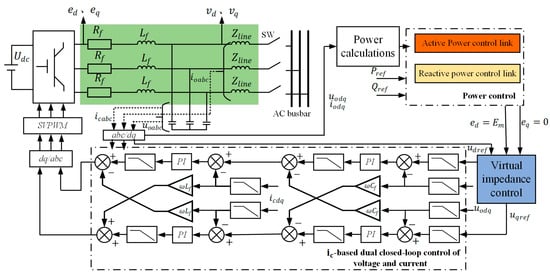
Figure 6.
Main circuit topology and control block diagram of VSG.
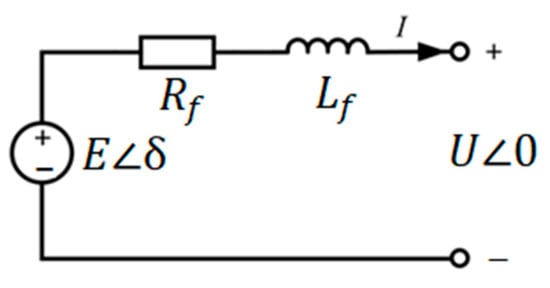
Figure 7.
Equivalent circuit diagram of VSG.
According to Figure 7 and the principle that the phases of the complex power impedance are consistent, the output complex power of the VSG is as follows:
In Equation (14), is the conjugate vector of the output current of the VSG. The active power and reactive power output by the VSG are as follows:
Since the resistance of the inductor in the VSG filter circuit is small, , at this time , and Equation (15) can be simplified as follows:
The inertia time constant is often used to measure the inertia of synchronous generators of different levels and powers [16], and can be expressed as follows:
In the equation, is the rated power of the VSG.
Defining yields the following:
Combining Equations (3), (17), and (18):
Let the rated power of the VSG be the active power, that is , then the reference value of the torque is , and , and Equation (19) can be simplified as follows:
In the equation, and are the per-unit values of the mechanical torque and electromagnetic torque.
When the output angular frequency per-unit value =1, the power-per-unit value , and Equation (20) can be simplified as follows:
Performing Laplace transformation:
And from Equation (16), is obtained when , , where denotes the per-unit value of the synchronous power.
The power angle of the VSG is . Performing Laplace transformation yields the following:
From Equations (22) and (23), the small-signal model of the VSG is obtained, and its model block diagram is shown in Figure 8.

Figure 8.
Small-signal model block diagram of VSG.
3. Problems of Active Power, Low-Frequency Oscillation and Steady-State Error of VSG
3.1. Influence of Virtual Damping Parameters ()
Through analysis of the active power–frequency control structure, the closed-loop transfer function of is obtained, revealing that is influenced by grid frequency and the active power reference:
Small-signal models for the VSG output active power in response to active power reference commands and the grid angular frequency are as follows:
Examination of the model functions confirms their adherence to a canonical second-order system structure. Figure 9 shows the pole distribution of the active power closed-loop small-signal model of the VSG when the moment of inertia is 0.7, 1, and 1.5, respectively, and the damping parameter changes from 0 to 50 with a step of 0.3.

Figure 9.
Pole distribution of active power, closed-loop, small-signal model of VSG with different when D increases.
Analysis reveals that as the moment of inertia increases, the closed-loop system poles shift toward the imaginary axis, making the VSG output active power more prone to instability and inducing active power oscillations during the response to active power commands. As increases continuously, a pair of conjugate poles and of the closed-loop system gradually approach the real axis away from the imaginary axis. When the damping parameters reach a certain value, these conjugate poles become two distinct negative real poles, driving the system into an overdamped state and enhancing its stability. Therefore, in the active power control loop, the moment of inertia primarily regulates the oscillation amplitude during dynamic response, and the damping parameters mainly affect the attenuation rate of the active power dynamic response, improve the system stability, and suppress the active power oscillation.
Analyzing the closed-loop function of the system yields the natural oscillation angular frequency and the damping ratio ζ of the system:
From Equation (27), it can be determined that as increases continuously, and ζ will decrease. According to the typical control theory, this dual decrease reduces the control bandwidth of the VSG grid-connected active power control system, diminishes the damping of the synchronous generator, slows the dynamic response speed of VSG control, and increases the dynamic oscillation amplitude. In addition, an increase in the damping parameters will elevate the damping ratio ζ, which helps to reduce the low-frequency dynamic oscillation phenomenon of the system.
3.2. Low-Frequency Oscillation and Steady-State Error Problems of VSG
When the VSG operates stably, its steady-state output angular frequency matches the grid frequency . When the grid frequency changes, the system adjusts the output active power to synchronize with the frequency, as dictated by the VSG’s active power–frequency regulation characteristics. The steady-state error of the VSG’s active power can be derived from Equation (25).
As indicated by Equation (28), the steady-state error of the output active power of the VSG during frequency tracking is . Evidently, the introduction of the damping coefficient augments the active power droop coefficient, thereby leading to an increase in . This presents a contradiction in comparison to the analysis of the impact of the damping parameter on the dynamic response of the system. On one hand, the VSG system necessitates an increase in the damping parameter to enhance the system damping ratio, thereby suppressing low-frequency active power oscillations and reducing system overshoot. On the other hand, steady-state error analysis indicates that increasing leads to larger power deviations. This creates a conflict in determining the optimal damping coefficient for balancing the dynamic and steady-state performance of the VSG.
Figure 10 presents the output active power curves of the VSG under different damping parameters . At 3–4 s, the grid frequency drops from 50 Hz to 49.8 Hz, and in order to track this frequency variation, the VSG will augment its output active power.

Figure 10.
Plot of the output active power of the VSG at different D.
4. Active Power Differential Feedforward Compensation Strategy
The Introduction outlines that the VSG enhances system damping through the inclusion of an auxiliary damping control loop. Figure 11 illustrates four methods to add such a loop: active power differential feedforward compensation, frequency differential feedback compensation, active power differential feedback compensation, and reactive power feedforward damping compensation. All of the above methods can effectively solve the problems of the active power, low-frequency, dynamic oscillation and steady-state error of the VSG, but there will be problems in the output frequency process. This study focuses on analyzing PFFCVSG [14,15], whose closed-loop active power control block diagram of this method is shown in Figure 12.
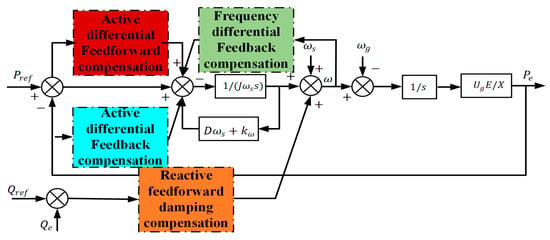
Figure 11.
Added additional damping control loop topology diagrams.
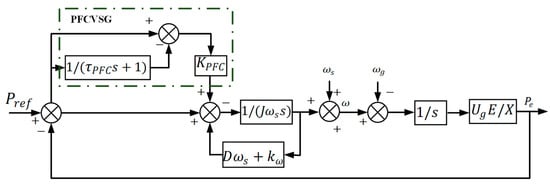
Figure 12.
Closed-loop active power control block diagram of PFFCVSG.
The control loop transfer function of PFFCVSG is as follows:
where is the lag time constant and is the compensation coefficient.
After adding the additional damping control loop, the rotor swing equation in the VSG active power control loop becomes the following:
where is a transient impedance formed by the feedforward compensation loop and in the steady state, ; consequently, the steady-state performance of the VSG remains uncompromised. In this control method, the damping parameter is set to 0, eliminating the coupling phenomenon of the droop coefficient caused by , while adding transient damping for damping supplementation.
The small-signal model of the grid-connected active power of PFFCVSG [14] under the disturbance of the active power reference value is as follows:
where the expressions of the coefficients and are as follows:
Comparison of Equations (24) and (31) reveals that the PFFCVSG control strategy introduces a pair of zero-pole pairs into the small-signal model’s closed-loop system. It can be seen that when is small, the PFFCVSG is approximately the same as the traditional VSG, so the feedforward compensation effect is not obvious at this time. Since generally takes a large value, the values of and do not require excessively large values. Figure 13 shows the pole distribution diagram of PFFCVSG under varying compensation coefficients : with the of PFFCVSG remaining at 0.006, changes from 0 to 30 in steps of 0.3. Figure 14 shows the pole distribution diagram of PFFCVSG when the time lag constant is changed. While remains constant at 1, changes from 0 to 30 in steps of 0.003.
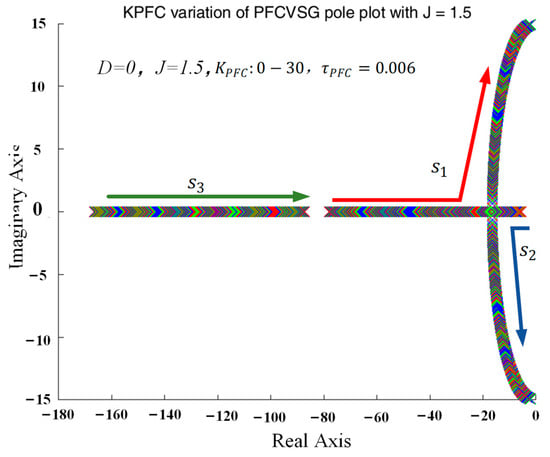
Figure 13.
Pole distribution diagram of the active closed-loop system with constant and variable given.
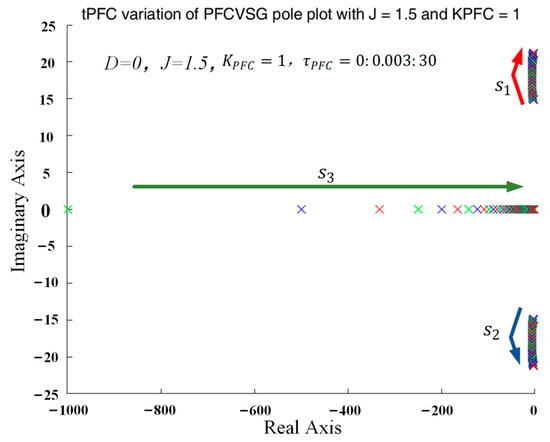
Figure 14.
Pole distribution diagram of the active closed-loop system with constant and variable given.
In Figure 13, the active power closed-loop system of PFFCVSG exhibits an additional negative real pole away from the imaginary axis compared to the VSG, which is consistent with the theoretical analysis. As the compensation coefficient gradually increases, gradually approaches the imaginary axis while always being away from it. Here, the main analysis focuses on the dominant poles and . With the increase of , the pair of dominant poles gradually approach the real axis and finally become a pair of real poles, and the system becomes in an overdamped state. Therefore, PFFCVSG can effectively avoid dynamic oscillation and at the same time avoid the active power steady-state error.
In Figure 14, when the time lag constant continuously increases, ignoring the influence of the negative real pole away from the imaginary axis, the dominant poles and exhibit a trend of first moving away from the imaginary axis and then approaching it, but the change range is very small. During the change process, the damping ratio of the system changes from 0.196 to 0.309 and then gradually increases to around 0.196, with a change range of about 0.113. Therefore, has little influence on the system. However, by observing the pole , analysis indicates that with the gradual increase of , the system poles rapidly approach the imaginary axis. However, since its distance from the imaginary axis remains significantly larger than that of the dominant pole pair, it cannot become a dominant pole. In order to reduce the influence of the non-dominant pole on the stability of the system, the value of needs to be set very small, which also aligns with the definition of the lag time constant. Thus, theoretical analysis shows that assumes a very small value. Reduced-order simplification of Equation (31) yields the following:
Analysis of Equation (33) confirms that the simplified model represents a canonical second-order control system. Thus, the and the ζ of PFFCVSG can be obtained as Equation (34), respectively. At the same time, the phase margin of the system can be obtained as Equation (35).
According to the theory of a typical second-order control system, ζ takes a value in , and . Thus, based on the theory and Equations (34) and (35), the tuning of the parameters and can be obtained. Considering the pole distribution of the system, to achieve a critical damping state, this study specifically selects the parameters and .
The feedforward compensation strategy based on PFFCVSG can effectively solve the contradiction between the low-frequency oscillation and steady-state error of the active power of the VSG, but it leads to the absence of damping and insufficient fixed inertial support in the VSG. This is because when is set to 0, it brings about three main impacts:
- It disrupts the damping feedback mechanism of VSG in the theoretical model;
- It causes sustained oscillations in system stability;
- It exacerbates frequency and power fluctuations in the dynamic response.
It thereby weakens the VSG’s simulation effect on physical damping. Consequently, it results in a decrease in the system’s damping ratio . Therefore, there will be a certain frequency overshoot problem in the dynamic tracking process. As shown in Figure 15, when takes values of 7, 10.5, and 19.5, respectively, it can be seen that as the value of increases, the frequency oscillation phenomenon of PFFCVSG can be alleviated, but its frequency overshoot value will increase. Excessive frequency overshoot may damage the converter equipment.
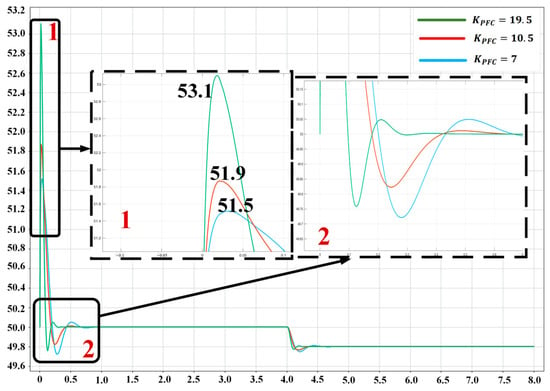
Figure 15.
Frequency overshoot of PFFCVSG.
5. Adaptive Virtual Inertia Adjustment Method Based on PFFCVSG
5.1. Analysis of Adaptive Virtual Inertia Constant
Based on the above analysis of PFFCVSG, it can be seen that the inertia support capability of this method is attenuated. Thus, in response to this characteristic, this article proposes an adaptive virtual inertia method (PFFCVSG_AJ) based on PFFCVSG. The block diagram of the active power closed-loop system of PFFCVSG_AJ is shown in Figure 16.

Figure 16.
Block diagram of the PFFCVSG_AJ system.
This study investigates the impact of variations in on the system within the PFFCVSG framework. Figure 17 shows the closed-loop active power pole diagram when changes from 1 to 10 in steps of 0.01.

Figure 17.
Pole distribution diagram of PFFCVSG active closed-loop system with value changing.
It can be observed that after adding PFFCVSG to the system, according to the determination of the time lag constant and the compensation coefficient in the previous section (), the system works in an overdamped state. As increases, the real part of pole of the system gradually decreases, while the imaginary part first remains unchanged and then gradually increases, and finally decreases gradually. The change range of the real part of pole is small. Compared to the other two poles, the position of the pole is farther from the imaginary axis, and this pole has less influence on the system. Thus, the analysis primarily focuses on the movement of with change. To ensure system stability and dynamic performance, the real part of the pole must be at least less than −5, and its imaginary part should remain within a small range. Consequently, when adding adaptive virtual inertia, it is necessary to enhance the inertia support ability of the system and also ensure that the change in is within a certain range.
In this method, the active power rotor swing equation of VSG changes to the following:
where is the proposed adaptive virtual inertia constant. represents a function of frequency deviation () and the rate of frequency deviation ), as .
By linearizing at the equilibrium point () and letting and , we can obtain the following:
By incorporating the active power equation , we can obtain the closed-loop characteristic equation:
The damping ratio and natural frequency are as follows:
Therefore, it is necessary to adjust to ensure that the system operates in a stable state. The method proposed in this article changes according to the RoCoF of the VSG system. The virtual moment of inertia is increased according to the frequency change . Since the upper limit of the maximum virtual moment of inertia of VSG is related to the instantaneous power capacity of the DC capacitor of the converter [25], its DC capacitor satisfies the following:
where is the maximum rate of change in grid frequency. According to GB/T 15945—2008 in China [26], under the normal operating conditions of the power system, the absolute value of the frequency deviation should be within 0.2 Hz, and it can be relaxed to 0.5 Hz when the system capacity is small. In this case, the RoCoF is usually small. For the active power loop of the VSG, during the primary frequency regulation process, it is required that the lag time of the primary frequency regulation should not be greater than 1s, the rise time should be less than 3 s, and the regulation time should not be greater than 4s. Through the RoCoF, there will be a fluctuation range of in a short time [27]. Therefore, this study adopts .
Thus, the change range of the adaptive virtual inertia constant can be obtained:
For a photovoltaic converter with an active power reference of 17 kW in this study, under the condition of rapid load change or grid fluctuation, the instantaneous power capacity of its DC capacitor is generally about 12 kW or higher. Under this condition, substituting it into the equation, it can be determined that the adaptive virtual moment of inertia needs to satisfy during the dynamic tracking process.
5.2. Coordinated Control Method Based on PFFCVSG_AJ
When the system is subjected to disturbances such as grid frequency fluctuations or active power command variations, the PFFCVSG system output power varies, causing corresponding changes in the system frequency. In the PFFCVSG_AJ system, the current system frequency deviation and its rate of change are expressed as follows:
Analysis of the equation reveals that a larger moment of inertia J endows the VSG with stronger inertial characteristics, leading to a small absolute of . A decrease in necessitates reducing the variation range of . Figure 18 shows the power angle characteristic curve of a typical VSG and the dynamic tracking curve of the rotor angular frequency . In the tracking process, the adaptive virtual inertia constant is adjusted in four distinct stages to optimize the system response.
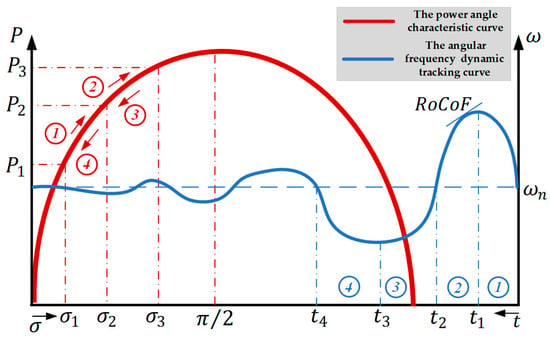
Figure 18.
The power angle characteristic curve of a typical VSG and the angular frequency dynamic tracking curve of the rotor.
- In interval ①, RoCoF first increases and then decreases to 0. This is because when the power increases from to , the input power of the system increases, resulting in an acceleration trend of the angular velocity , which leads to an increase in RoCoF. As the system gradually adjusts, RoCoF gradually decreases to 0. In this interval, , the actual angular velocity of the system is greater than the rated angular velocity , the system is in an accelerating state, and the frequency increases. At this time, it is necessary to appropriately increase to suppress the excessive frequency change.
- In interval ②, the power continues to change from , first increases and then gradually decreases, and at this time, and is in a decelerating state. In this interval, and the actual angular velocity is still greater than the rated angular velocity but is gradually decreasing. At this time, can be appropriately reduced because the system needs to adjust the frequency more quickly. A smaller can reduce the inertia of the system within an appropriate range to accelerate the response speed and make return to the rated angular velocity more quickly.
- In interval ③, the power decreases from to ; at this time and deviates from in the reverse direction. At this time and the frequency gradually decreases. In this interval, it is necessary to increase . A larger can increase the inertia of the system, making the system’s response to frequency changes slower and suppressing the reverse deviation trend.
- In interval ④, the power decreases from to ; at this time and starts to accelerate and recover in the positive direction. In this interval, and gradually increases and approaches . At this time, it is necessary to reduce within the specified range, appropriately reduce the inertia of the system, and make respond to power changes more quickly and reduce the time to return to .
Through the above analysis of and , this study derives the variation of across different intervals. The active power rotor motion equation of PFFCVSG_AJ in this study is as follows:
where represents the detected of the system; and , and are the adjustment coefficients of and , which are used to adjust in the case of small perturbations of and large perturbations of . is the change threshold of and is the change threshold of . and are first-order inertial links. When adjusting the inertia according to the size and change trend of , the existence of this link can have a certain inertia and delay, thereby avoiding the impact of sudden changes in inertia on the system. Figure 19 shows the control flow diagram for .
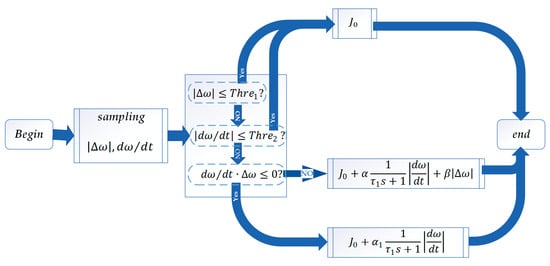
Figure 19.
Adaptive control of moment of inertia .
In this study, the parameter determination for and falls under empirical threshold parameters.
- For the parameter, its role is to avoid the frequent charging and discharging of devices caused by minor frequency fluctuations. It is set according to the allowable frequency deviation range of the system. As described in Section 5.1, within a small-system-capacity range, the frequency deviation is ±0.5 Hz; thus is set to 0.5.
- The setting of the parameter is combined with the dynamic response characteristics of the system, and needs to be determined by the minimum rate of frequency change that can trigger the condition. According to the content in [23], it is determined that the maximum rate of frequency change in the system is ; thus can be set as a safety margin close to this value ().
The parameters and are mainly used to coordinate the adjustment of J for under small disturbance conditions, whereas is used to adjust J for large disturbance conditions of ω. These parameters can be adjusted according to actual conditions.
5.3. Performance Analysis of PFFCVSG_AJ Under External Disturbances
5.3.1. Theoretical Analysis Under Grid Frequency Disturbance
When the frequency of the power grid is disturbed (for example, from to ), the system senses large disturbances and through frequency, as well as small disturbances and a frequency change rate of , which are used as the input of the adaptive virtual inertia adjustment. According to the piecewise control logic method proposed in Equation (21) (), the virtual inertia can be increased by a couple, thus enhancing the inertial support of the system.
At the same time, it can be seen from the rotor motion equation of Equation (36) () that when the virtual inertia increases, the change rate of frequency can be effectively reduced, and decreases under the same power difference, thus effectively suppressing the change range of frequency.
5.3.2. Theoretical Analysis Under Load Mutation
When the system load changes abruptly, VSG needs to balance the mechanical power and electromagnetic power quickly [28]. The adaptive regulation of in PFFCVSG_AJ can play the key role in the following two aspects:
- Load mutation identification: When the load changes abruptly, the output power of the system will change rapidly. By sensing the power change rate , the system can quickly sense the load change and quickly trigger the adjustment of the virtual inertia .
- Virtual inertia transient increases: When the load change is perceived, the can be quickly increased, thereby extending the window of power balance, so that the frequency and voltage do not fluctuate greatly.
It is pointed out in [29] that from the perspective of energy conservation, the virtual inertia essentially plays the role of ‘energy buffer’. Equation (45) indicates that when increases, more kinetic energy can be stored better, which can offset the power impact in the face of sudden load changes, thus suppressing the overshoot of frequency.
In the rotor angular frequency tracking curve in Figure 18, PFFCVSG_AJ mainly undergoes three stages when load suddenly changes. Transient buffering (0 – ): With an increase in , the frequency and voltage fluctuations are constrained within a narrow range. Dynamic regulation (): Under the dual coordination of feedforward compensation and droop control in the system, in the face of load changes, is quickly adjusted to match the working conditions, and gradually changes to the reference value. Restoring steady state (): Due to the effect of feedforward compensation, the steady-state error can be gradually eliminated, and the system gradually transitions to a stable state.
6. Simulation Results
To verify that the PFFCVSG_AJ method proposed in this article effectively addresses active power low-frequency oscillation, eradicates active power steady-state errors, and mitigates overshoot during frequency tracking, a relevant model was established in MATLAB/Simulink (MathWorks, R2022b, Natick, MA, USA). The system parameters are listed in Table 1, and the VSG simulation system is shown in Figure 6.

Table 1.
The main parameters of the VSG.
6.1. Comparative Simulation Verification
Under the same VSG parameters, comparative verification is conducted for the traditional VSG, PFFCVSG method, and the proposed PFFCVSG_AJ control method in this study. The simulation conditions are as follows: the VSG power reference values are set to and , with the grid frequency varying from 50 Hz to 49.8 Hz at t = 4 s. Figure 20 illustrates the active power tracking responses to frequency variations under the three control methods. Observation of the graph reveals that the traditional VSG exhibits significant steady-state errors. In contrast, the proposed PFFCVSG_AJ method effectively suppresses active power oscillations and eliminates steady-state errors when compared across the three methods. Notably, PFFCVSG_AJ demonstrates slight overdamping, which arises from the time-dependent variation in the virtual inertia in the algorithm as it transitions from a smaller value. The relevant parameters are listed in Table 2.
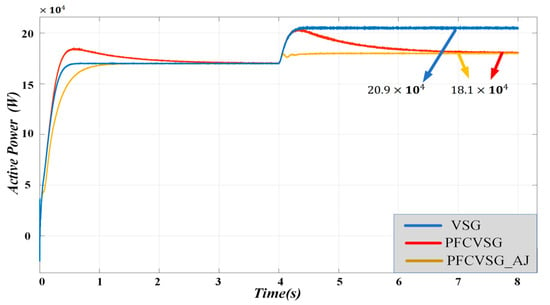
Figure 20.
Comparison of active power curves of PFFCVSG and PFFCVSG_AJ.

Table 2.
Quantitative indicators.
The frequency tracking curves of the PFFCVSG and PFFCVSG_AJ control methods are shown in Figure 21. It can be observed that the of the method proposed is 0.88 Hz, which has an improvement of 2.21 Hz in frequency offset compared to the 3.09 Hz of PFFCVSG, greatly reducing the threat of frequency overshoot to the system.

Figure 21.
Comparison of the frequency curves of PFFCVSG and PFFCVSG _AJ. (a) The frequency curve of PFFCVSG; (b) the frequency curve of PFFCVSG_AJ.
The of the two control methods is shown in Figure 22. It can be observed that when the method proposed is adopted, the system RoCoF can be kept below 1 Hz/s, and during the dynamic tracking process of the grid frequency, the maximum value of is 0.869 Hz/s, compared to the 0.961 Hz/s of the PFFCVSG method, demonstrating a notable improvement. This enhancement stabilizes the converter’s frequency output, mitigates transient system oscillations following disturbances, and more effectively preserves system frequency stability.

Figure 22.
Comparison of the of PFFCVSG and PFFCVSG _AJ. (a) The of PFFCVSG; (b) the of PFFCVSG_AJ.
Table 3 lists the maximum frequency deviation (), , and dynamic performance stabilization times of different control methods. Comprehensive comparison shows that the method proposed has certain improvements in the above performance indicators.

Table 3.
Quantitative indicators.
6.2. Simulation Under the Condition of Changing the Active Power Command
To further validate the performance of the proposed method under variations in the active power command, the simulation conditions are set as follows: the system initially operates at , and at t = 3 s, the active power command changes to . The system parameters are listed in Table 2. The simulation results using the PFFCVSG_AJ are shown in Figure 23. Figure 23a depicts the active power tracking curve, showing that at 3s, the system output power changes from 17 kW in accordance with the active power command, and after an adjustment time of about 0.2 s, the system output power changes to 15 kW. Figure 23b illustrates the frequency tracking curve, where the is 0.6 Hz. Following the active power command tracking, the system output frequency returns to 50 Hz. Figure 23c shows the RoCoF tracking curve. The of the method proposed is 1.012 Hz/s, which complies with grid specifications. Figure 23d presents the tracking curve, demonstrating that the variation in the virtual inertia constant is smooth, with the range of satisfying . The various quantitative indicators under the condition of active power command change are listed in Table 4.

Figure 23.
Simulation results under the condition of active power command change: (a) Active power tracking curve; (b) frequency tracking curve; (c) tracking curve; (d) tracking curve.

Table 4.
Various quantitative indicators under the condition of active power command change.
6.3. Performance of PFFCVSG_AJ Under Different
Through the above analysis of the adaptive virtual inertia constant , it is evident that the determination of plays a decisive role in the change range of , and is crucial to the dynamic performance of the system. In this section, different values of (1, 2, 3) are set, and the results are shown in Figure 24.
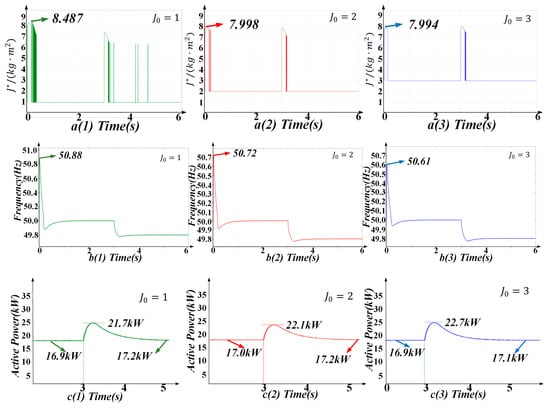
Figure 24.
Simulation results of different : (a(1)–(3)) Variation curve of ; (b(1)–(3)) variation curve of frequency; (c(1)–(3)) variation curve of active power.
Figure 24 present the results for , and , respectively. The quantitative data under different are shown in Table 5. Comparative analysis of the figures and table reveals the following:

Table 5.
Quantitative indicators under different .
- For different values of , the mutation problem of the virtual inertia constant is well suppressed, and the change range always meets the requirement range of . The larger the , the smoother the change of , which also verifies the previous analysis of the influence of on the system.
- The frequency mutation problem is well solved. The RFD of the system is basically in the range of 50.5–51 Hz, and as increases, the RFD value is smaller.
- The active power oscillation changes at 3 s due to the change in the grid frequency. Following the completion of frequency tracking, the active power can be stabilized near 17.2 kW. For different values of , the steady-state values of the active power exhibit minimal difference, which verifies that PFFCVSG_AJ only affects the dynamic performance of the system during the tracking process and does not change the steady-state value of the system, thus effectively solving the problem of the active power steady-state error.
7. Experimental Results
To verify the effectiveness of the proposed algorithm, experiments were performed using the electrical control system shown in Figure 25, which mainly includes a photovoltaic simulator, a PCS (power conversion system), and relevant loads. The PCS in this equipment uses a TMS320F28378DPTPS-type chip. To further verify the system’s robustness against external disturbances, additional experiments under abrupt load changes were conducted for validation.

Figure 25.
Electrical schematic diagram.
When the system load suddenly increases from 20% to 80% of the rated load, the output three-phase voltage and current waveforms of the system are shown in Figure 26. It can be observed that the waveforms of different channels (the voltage waveforms of Channels 1–3 and the current waveform of Channel 4) present regular sine shapes, which verifies the synchronization and sine degree of the voltage and current during the steady-state operation of the system under this strategy. When the load suddenly increases, the voltage sag amplitude is controlled within 5% and recovers to the original level within a certain period; the current inrush peak does not exceed 1.2 times the rated value and stabilizes within 20 ms; the frequency deviation converges rapidly, and the frequency is maintained at 49.7983 Hz (almost 50 Hz), meeting the primary frequency regulation capability of the algorithm. These results demonstrate that the PFFCVSG_AJ adaptive virtual inertia adjustment and active power compensation mechanism can effectively suppress transient fluctuations and enhance the system’s dynamic response capability.
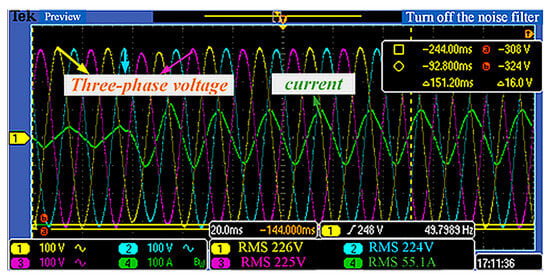
Figure 26.
The output voltage and current waveform when load suddenly increases from 20% to 80% of the rated capacity.
When the system load suddenly decreases from 100% to 80% of the rated load, the output three-phase voltage and current waveforms of the system are shown in Figure 27. It can be observed that the waveforms of different channels (the voltage waveforms of Channels 1–3 and the current waveform of Channel 4) exhibit regular sinusoidal patterns, verifying the synchronization and sinusoidality of the voltage and current during the steady-state operation of the system under this strategy. When the load suddenly decreases, the voltage overshoot is controlled within 3%. The current rapidly follows the load change, with the inrush amplitude not exceeding 1.1 times the rated value, and it recovers to a sinusoidal state within 15ms. The active power (related to the product of voltage and current) quickly tracks the load adjustment, with the oscillation amplitude reduced by 55% compared to the traditional VSG and 30% compared to the PFFCVSG. In the face of a sudden load decrease, the frequency is maintained at 49.9939 Hz (almost 50 Hz). These results demonstrate that the PFFCVSG_AJ proposed in this study can effectively eliminate the steady-state active power error and suppress transient fluctuations in voltage and current.
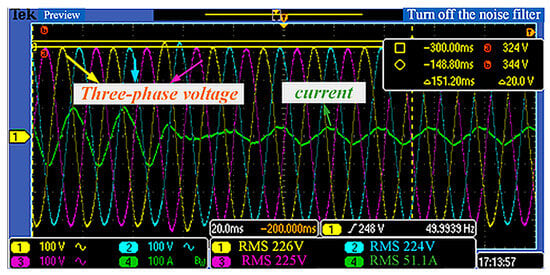
Figure 27.
The output voltage and current waveform of the load is abruptly reduced by 100% of the rated load by 20%.
A YOKOGAWA-WT186E power analyzer is employed to measure the total harmonic distortion (THD) of the system’s output voltage under normal operating conditions, the results are shown in Figure 28. The values of the , , and channels represent the THD values of the three-phase output voltage. The measurement results of the power analyzer show that the THD values of the three-phase voltage are all less than 2%, complying with Standards [25]. The results indicate that the microgrid with PFFCVSG_AJ can effectively connect to the grid without affecting the power quality of the grid.

Figure 28.
The THD value of the output voltage.
8. Discussion and Conclusions
This article focuses on the grid-connected damping issues of the virtual synchronous generator (VSG). The operational and control principles of the VSG are elaborated upon in detail, analyzing them through a small-signal model. The influence of the damping coefficient on active power regulation is explored, revealing that increasing the damping coefficient can suppress low-frequency oscillations but introduce steady-state errors. The problem that the PFFCVSG strategy leads to frequency overshoot is analyzed and concluded. Furthermore, an adaptive virtual inertia adjustment method (PFFCVSG_AJ) is proposed. By adjusting the virtual inertia based on the rate of change in frequency (RoCoF), the variation range is determined.
Simulation results confirm that PFFCVSG_AJ outperforms PFFCVSG in suppressing power oscillations, eliminating the steady-state error, and solving the frequency overshoot phenomenon. Simulations with different values of demonstrate that this parameter only affects the dynamic performance of the method without altering its stability. Additionally, experiments with abrupt load changes have verified the effectiveness of the algorithm. The measured THD values of the output demonstrate that the microgrid employing PFCVSG_AJ can achieve efficient grid connection. Overall, this research provides an important solution for the grid-connected operation of VSG.
In the future, the method will be further improved, and the impacts of capacitor aging and equipment temperature on will be considered in practical applications; these are the potential challenges that PFFCVSG_AJ will face during its implementation. The relevant theories of this method in the parallel operation mode of the VSG will be explored; meanwhile, the influence of communication on the method in actual projects will be studied, etc.
Author Contributions
Conceptualization, X.C. and R.Z.; methodology, X.C. and R.Z.; software, R.Z., J.G. and B.L.; validation, R.Z., J.L. and L.J.; formal analysis, X.C.; investigation, R.Z.; resources, X.C., J.L. and X.W.; data curation, R.Z.; writing—original draft preparation, R.Z.; writing—review and editing, X.C. and X.W.; visualization, R.Z.; supervision, X.C. and X.W.; project administration, X.C., L.J. and X.W.; funding acquisition, J.L. and X.C. All authors have read and agreed to the published version of the manuscript.
Funding
This research was funded by the ‘Major Scientific Research Instrument Development Program of National Natural Science Foundation of China 52227804’.
Data Availability Statement
This article documents the original contributions of this study. For further information, please contact the corresponding author.
Conflicts of Interest
The authors declare no conflicts of interest.
Abbreviations
The following abbreviations are used in this manuscript:
| VSG | Virtual synchronous generator |
| SG | Synchronous generator |
| PFFCVSG | Active power differential feedforward compensation strategy |
| PFFCVSG_AJ | Adaptive virtual inertia method based on PFFCVSG |
| RoCoF | Rate of change in frequency |
| SSOP | Steady-state operating point |
References
- Lyu, Z.P.; Sheng, W.X.; Zhong, Q.C.; Liu, H.T.; Zeng, Z.; Yang, L.; Liu, L. Virtual synchronous generator its application in microgrid. Chin. J. Electr. Eng. 2014, 34, 2591–2603. [Google Scholar] [CrossRef]
- Yan, L.Q.; Zhao, Z.; Ullah, Z.; Deng, X.W.; Zhang, Y.Y.; Shah, W.A. Optimization of optical storage VSG control strategy considering active power deviation and virtual inertia damping parameters. Ain Shams Eng. J. 2024, 15, 103131. [Google Scholar] [CrossRef]
- Lu, S.; Zhu, Y.; Dong, L.; Na, G.; Hao, Y.; Zhang, G.; Zhang, W.; Cheng, S.; Yang, J.; Sui, Y. Small-Signal Stability Research of Grid-Connected Virtual Synchronous Generators. Energies 2022, 15, 7158. [Google Scholar] [CrossRef]
- Qi, X.; Zheng, J. VSG Control for Cascaded Three-Phase Bridge Based Battery Inverter. World Electr. Veh. J. 2023, 14, 203. [Google Scholar] [CrossRef]
- Shi, R.L.; Wang, B.; Huang, J.; Wang, G.B.; Lan, C.H. Analysis and Improvement Strategy of Grid-Connected Damping Characteristics of Energy Storage Virtual Synchronous Machine. Acta Energiae Solaris Sin. 2023, 44, 30–38. [Google Scholar] [CrossRef]
- Shi, R.L.; Lan, C.H.; Dong, Z.; Yu, Y.N.; Zhong, Z.X. An Active Power Oscillation Damping Strategy for Grid-Forming Energy Storage Virtual Synchronous Generator (VSG) Based on Energy Reconfiguration. Acta Energiae Solaris Sin. 2025, 46, 300–308. [Google Scholar] [CrossRef]
- Zhou, N.G.; Xie, X.T.; Ma, J.J.; Yu, H.F.; Li, Y.; Xie, Y.Z. Adaptive Virtual Inertia-Damping Control for Wind Farm-Equipped Energy Storage. J. Electr. Sci. Technol. China 2024, 39, 150–158. [Google Scholar] [CrossRef]
- Dong, S.; Chen, Y.C. Adjusting synchronverter dynamic response speed via damping correction loop. IEEE Trans. Energy Convers. 2017, 32, 608–619. [Google Scholar] [CrossRef]
- Li, C.; Yang, Y.; Mijatovic, N.; Dragicevic, T. Frequency stability assessment of grid-forming VSG in framework of MPME with feedforward decoupling control strategy. IEEE Trans. Ind. Electron. 2022, 69, 6903–6913. [Google Scholar] [CrossRef]
- Lan, C.H.; Shi, R.L.; Wang, G.B.; Zhou, Q.F.; Liu, W.S. Optimization Strategy for Grid-Connected Active Power Response of Energy Storage VSG Based on Frequency Feedforward Compensation. Acta Energiae Solaris Sin. 2024, 45, 236–243. [Google Scholar] [CrossRef]
- Xiong, X.L.; Li, X.; Luo, B.; Huang, M.; Zhao, C.; Blaabjerg, F. An Additional Damping Torque Method for Low-Frequency Stability Enhancement of Virtual Synchronous Generators. IEEE Trans. Power Electron. 2024, 39, 15858–15869. [Google Scholar] [CrossRef]
- Chen, S.M.; Sun, Y.; Han, H.; Luo, Z.Z.; Shi, G.Z.; Yuan, L.; Guerrero, J.M. Active power oscillation suppression and dynamic performance improvement for multi-VSG grids based on consensus control via COI frequency. Int. J. Electr. Power Energy Syst. 2023, 147, 108796. [Google Scholar] [CrossRef]
- Ling, S.; Liu, R.H.; Zhang, C.Y.; Wang, X.D.; Yang, X.W. Subsynchronous oscillation suppression strategy of virtual synchronous generator based on dynamic inertia damping coefficient. China South. Power Grid Technol. 2025, 1–10, in press. Available online: https://nfdwjs.csg.cn/gateway-web/en/debutDetail.html?serialNum=20241220001 (accessed on 14 June 2025).
- Lan, Z.; Long, Y.; Zeng, J.H.; Tu, C.M.; Xiao, F.; Guo, Q. Transient Power Oscillation Suppression Strategy of Virtual Synchronous Generator Considering Overshoot. Autom. Electr. Power Syst. 2022, 46, 131–141. [Google Scholar] [CrossRef]
- Zhuo, Q.; Liu, W.; Xu, Z.; Zhang, H.; Zhai, Y.; Yang, L. Active Power-Frequency Oscillation Suppression Strategy for Parallel VSG Grid-Connected Power System. In Proceedings of the 2024 10th International Conference on Power Electronics Systems and Applications (PESA), Hong Kong, China, 5–7 June 2024. [Google Scholar] [CrossRef]
- Bal, G. Performance Analysis of Field-Orientation Controlled Induction Motor with Parameter Adaptation; University of Strathclyde: Glasgow, UK, 1993. [Google Scholar]
- Ban, G.; Xu, Y.; Guo, D.; Zhou, W.; Zheng, H.; Yuan, X. Research on adaptive VSG control strategy based on inertia and damping. In Proceedings of the 2021 IEEE International Conference on Sustainable Power and Energy (iSPEC), Nanjing, China, 23–25 December 2021. [Google Scholar] [CrossRef]
- Jain, A.; Pathak, M.K.; Padhy, N.P. Conjoint Enhancement of VSG Dynamic Output Responses by Disturbance-Oriented Adaptive Parameters. IEEE Trans. Ind. Inform. 2024, 20, 2079–2096. [Google Scholar] [CrossRef]
- Zhang, C.; Yang, Y.; Miao, H.; Yuan, X. An improved adaptive inertia and damping control strategy for virtual synchronous generator. In Proceedings of the 2018 13th IEEE Conference on Industrial Electronics and Applications (ICIEA), Wuhan, China, 31 May–2 June 2018. [Google Scholar] [CrossRef]
- Yan, L.Q.; Deng, X.W.; Zhao, Z.; Zhang, Y.Y.; Yuan, Y.; Peng, P.P. VSG Power Decoupling Control Strategy Based on Adaptive Feedforward Compensation. Power Syst. Prot. Control 2024, 52, 64–73. [Google Scholar] [CrossRef]
- Chen, S.; Sun, Y.; Han, H.; Shi, G.; Guan, Y.; Guerrero, J.M. Dynamic Frequency Performance Analysis and Improvement for Parallel VSG Systems Considering Virtual Inertia and Damping Coefficient. IEEE J. Emerg. Sel. Top. Power Electron. 2023, 11, 478–489. [Google Scholar] [CrossRef]
- Zhong, Q.C.; Weiss, G. Synchronverters: Inverters That Mimic Synchronous Generators. IEEE Trans. Ind. Electron. 2011, 58, 1259–1267. [Google Scholar] [CrossRef]
- Liu, H.; Gao, S.A.; Sun, D.W.; Song, P.; Wang, X.S.; Cheng, X.K. Small-Signal Stability Analysis of Photovoltaic Virtual Synchronous Generator Grid-Connected. Acta Energiae Solaris Sin. 2021, 42, 417–424. [Google Scholar] [CrossRef]
- Zhang, X. Advanced Power Electronics Technology; China Machine Press: Beijing, China, 2011. [Google Scholar]
- Cheema, K.M. A comprehensive review of virtual synchronous generator. Int. J. Electr. Power Energy Syst. 2020, 120, 106006. [Google Scholar] [CrossRef]
- GB/T 15945-2008; Power Quality-Power System Frequency Deviation. Standards Press of China: Beijing, China, 2008.
- Wang, L.; Ren, J.; Huang, G.; Xie, L.; Feng, C.; Zhang, Y. Identifying the Largest RoCoF and Its Implications. IEEE Trans. Power Syst. 2025, 40, 1164–1167. [Google Scholar] [CrossRef]
- Zheng, C.; Sun, H.D.; Zhang, H.Y.; Du, Y. Transient power angle stability emergency control of VSG single-machine grid-connected system based on network disturbance response. Chin. J. Electr. Eng. 2025, 1–13, in press. [Google Scholar]
- Zhang, C.W.; Shi, Y.F.; Zhan, X.; Liu, Z.H.; Sun, L. TMD control system based on motion form transformation using rotational inertia virtual translational inertia mass. Vib. Eng. J. 2024, 37, 1377–1385. [Google Scholar]
Disclaimer/Publisher’s Note: The statements, opinions and data contained in all publications are solely those of the individual author(s) and contributor(s) and not of MDPI and/or the editor(s). MDPI and/or the editor(s) disclaim responsibility for any injury to people or property resulting from any ideas, methods, instructions or products referred to in the content. |
© 2025 by the authors. Licensee MDPI, Basel, Switzerland. This article is an open access article distributed under the terms and conditions of the Creative Commons Attribution (CC BY) license (https://creativecommons.org/licenses/by/4.0/).